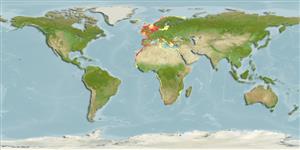分類 / Names
共通名の | 類義語 | Catalog of Fishes(部類, 種) | ITIS | CoL | WoRMS | Cloffa
>
Syngnathiformes (Pipefishes and seahorses) >
Syngnathidae (Pipefishes and seahorses) > Syngnathinae
Etymology: Syngnathus: Greek, syn, symphysis = grown together + Greek, gnathos = jaw (Ref. 45335).
More on author: Linnaeus.
Environment: milieu / climate zone / depth range / distribution range
生態学
海; 汽水性の 底生の; 移住性ではない (Ref. 88171); 深さの範囲 0 - 110 m (Ref. 4281), usually 3 - 15 m (Ref. 126547). Subtropical; 71°N - 35°S, 19°W - 42°E
Eastern Atlantic: Norway, Faroes and British Isles to Western Sahara, Senegambia, and from Namibia to Cape of Good Hope and northward to the coast of Zululand in the western Indian Ocean (Ref. 4127). Also throughout the Mediterranean, Aegean and Black seas. Despite literature records, occurrence in the Indo-Pacific outside South African waters lacks conclusive evidence (Ref. 4281).
Length at first maturity / サイズ / 重さ / 年齢
Maturity: Lm 16.3, range 7 - 25.6 cm
Max length : 50.0 cm TL オス/雌雄の選別がない; (Ref. 35388)
簡単な記述
検索表 | 形態学 | 形態計測学
背面の脊椎 (合計) : 0; 背鰭 (合計) : 33 - 42; 肛門の骨: 0; 臀鰭: 3. Light greenish to dark brown in color with variable markings (Ref. 4281). Snout cylindrical, equal to or less than eye diameter. With 18 - 19 body rings between head and dorsal fin (Ref. 35388). The snake pipefish (Entelurus aequoreus) is distinguished by the lack of pectoral and anal fins (Ref. 88171). An elongated bump on top of head behind eye (Ref. 59043).
Found in coastal and estuarine waters to depths of at least 110 m (Ref. 4281); on sand, mud and rough bottoms. Common amongst algae and eel-grass (Zostera) (Refs. 4146, 6733, 88187). Feeds mainly on small crustaceans (Ref. 85544). It is parasitised by the monogenean Gyrodactylus eyipayipi on the body surface, inside the flute and male brood pouch (Ref. 124059).
Ovoviviparous; reproducing on average 3 times each year (Ref. 89328). Several females depositing partial clutches to a male’s brood pouch under the tail (Refs. 205, 31201). Up to 400 eggs may be found in a single pouch (Ref. 89329). Brooding males occur mainly between May and July (Refs. 31201, 58137). During the breeding season, both males and females were observed to remain low amongst the seagrass in one meadow (Ref. 31201). Gestation period lasts about 5 weeks and size at birth is 1.7- 3.5 cm (Refs. 58137, 88187, 89330). Aquarium experiments have shown that new born young are benthic, remaining close to the bottom Ref. 89330).
Dawson, C.E., 1986. Syngnathidae. p. 628-639. In P.J.P. Whitehead, M.-L. Bauchot, J.-C. Hureau, J. Nielsen and E. Tortonese (eds.) Fishes of the North-eastern Atlantic and the Mediterranean. Volume 2. Unesco, Paris. (Ref. 6733)
Human uses
水産業: 興味がない; 水族館・水槽: 商業
用具
特記事項
XMLをダウンロードして下さい
インターネットの情報源
Estimates based on models
Preferred temperature (Ref.
123201): 10.3 - 22.6, mean 17.7 °C (based on 934 cells).
Phylogenetic diversity index (Ref.
82804): PD
50 = 0.5000 [Uniqueness, from 0.5 = low to 2.0 = high].
Bayesian length-weight: a=0.00025 (0.00019 - 0.00032), b=3.21 (3.16 - 3.26), in cm total length, based on LWR estimates for this species (Ref.
93245).
栄養段階 (Ref.
69278): 3.3 ±0.2 se; based on diet studies.
回復力 (Ref.
120179): 手段, 1.4年~4.4年の倍増期間の最小個体群 (Fec=200).
Fishing Vulnerability (Ref.
59153): Moderate vulnerability (40 of 100).
Nutrients (Ref.
124155): Calcium = 54.6 [12.4, 151.7] mg/100g; Iron = 1.02 [0.39, 3.52] mg/100g; Protein = 3.7 [0.1, 7.5] %; Omega3 = 0.286 [0.130, 0.629] g/100g; Selenium = 22.8 [5.1, 60.3] μg/100g; VitaminA = 9.35 [4.02, 21.44] μg/100g; Zinc = 0.838 [0.431, 1.605] mg/100g (wet weight);
